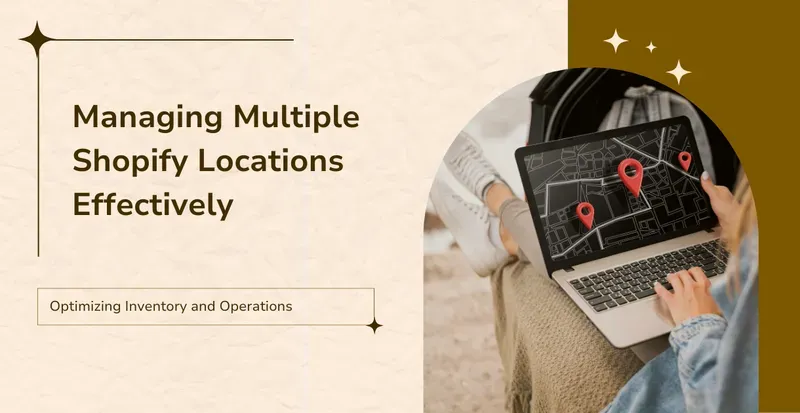Managing Multiple Shopify Locations Effectively
By Sonaksh Singh Rawat on

In today’s fast-paced online marketplace, it’s essential for retailers to meet customers’ expectations for swift delivery. A pivotal method to accomplish this is by enhancing order fulfillment strategies aan this is where Shopify location comes into the picture.
Retailers with a national or even global customer base cannot afford to rely solely on one fulfillment center, as this approach may hinder their ability to promptly serve all their clientele. Embracing a distributed inventory model enables retailers to use fulfillment or distribution centers nearest to their customers.
This method not only speeds up the delivery process but also provides retailers with more control and better oversight of their inventory spread out over various locations. Platforms such as Shopify have developed functionalities like Locations to further facilitate this streamlined process.
Those keen on improving their inventory management and growing their distribution network within the e-commerce landscape might find it useful to delve into the capabilities offered by Shopify Locations.
What Are Shopify Locations?
Online selling has fundamentally changed how retailers manage orders and expand their ventures. The shift towards a multichannel online presence has underscored the significance of location. As ventures grow, the diversity of venues for storing and handling stock broadens.
Within Shopify’s framework, a “location” refers to any physical site, including an internal warehouse or a dropship supplier’s location, used for sales, stocking inventory, or order fulfillment. This encompasses both the traditional brick-and-mortar stores.
Is There a Limit to How Many Shopify Locations You Can Manage?
The Shopify subscription plan selected determines the number of locations that can be established. Detailed information on the maximum number of locations per plan is provided, with the limits varying according to the plan:
- Shopify Lite: 3 locations
- Basic Shopify: 4 locations
- Shopify: 5 locations
- Advanced Shopify: 8 locations
- Shopify Plus: 20
Inventory management applications that physically store inventory count as locations. This category includes third-party logistic services, dropshipping applications, and custom fulfillment services.
For example, an application established to fulfill orders on behalf of the user is listed within their Shopify Locations settings and under custom fulfillment locations, though these do not count towards the limit of locations imposed by Shopify.
Moreover, deactivated locations do not count towards the plan limit. The number of locations set up can be reviewed by navigating to the Locations settings page on Shopify.
Using Multiple Shopify Locations
Businesses experience increasing complexity in managing inventory and fulfillment as they expand, particularly when operating across various channels and warehouse locations. The multi-location management function provided by Shopify enables businesses to assign and monitor their inventory across all storage or fulfillment locations. This feature greatly simplifies the processes of inventory management and order fulfillment.
By leveraging Shopify locations feature, businesses can efficiently keep track of their inventory across these different locations, allowing them to dedicate more time to other vital areas of their operations. Shopify facilitates the setup of multiple tracking and fulfillment locations through its settings, thereby improving the efficiency of inventory management and order fulfillment.
Additionally, Shopify locations assists in determining which locations might have either a surplus or a shortage of specific products. It clearly indicates when it is necessary to transfer products between locations or when orders should be placed with suppliers to send inventory to a specific location.
Each location within Shopify operates as a fulfillment center, maintaining accurate inventory levels for each SKU. Orders are allocated to locations based on pre-established priorities and SKU availability.
The setup of multiple Shopify locations is particularly advantageous for merchants in scenarios such as:
- Redirecting orders to another fulfillment center if the primary source is out of stock.
- Routing specific orders to one location while distributing the rest to another, depending on the nature of the orders or fulfillment methods.
- Accepting preorders on Shopify to be fulfilled at a later date.
- Managing international orders and needing flexible fulfillment options to optimize the process.
Why Multiple Locations?
Ecommerce businesses are adopting multichannel strategies, expanding into various distribution channels. This expansion encompasses options like dropshipping suppliers, retail stores, pop-up markets, marketplaces, warehouses, and other venues suitable for holding and managing inventory.
Shopify locations allows these businesses to independently sell products, ship or fulfill orders, and control inventory across each channel.
1. Effective Multi-Warehouse Management
Maintaining stock levels consistently presents a significant challenge for ecommerce businesses, as each process and component requires careful handling. By operating from more than one warehouse, products can be shipped to customers more promptly. This strategy not only reduces the labor required to deliver products but also lowers shipping costs.
A multi-warehouse inventory management solution enables real-time stock tracking through a single, unified system. As operations scale, the advantages of an effective distributed inventory system with multiple locations become more pronounced.
2. Providing Unique Shopping Experiences
Creating separate Shopify stores for distinct customer segments allows the personalization of the shopping experience, attracting new clients and standing out from competitors. This can be achieved by including local references or specific preferences in the design and marketing of products.
A business has the capability to set up various types of stores, such as a luxury boutique, a discount outlet, and a general store, all while operating under a single brand. This strategy enables efficient customer categorization, leading to an easier discovery process of their preferred products.
This method significantly simplifies the shopping journey by eliminating the need for customers to navigate through expansive menus to find what they are looking for. The goal is to make the ordering process as seamless as possible, thereby increasing the chances that a customer will complete a purchase.
3. Offering Local Pickup and Delivery
Gaining precise insight into the inventory data across various locations allows for the efficient routing of orders between different storefronts for those entities with multiple physical locations. This functionality also enables the provision for customers to buy products online and opt for in-store pickup, contingent upon the availability of inventory.
4. Exploring New Dropshipping Opportunities
Shopify locations are designed to support the integration of additional supplier catalogs and facilitate inventory tracking by location. This capability enables the expansion of the product catalog, allowing for a broader range of products to be offered to customers.
How to Fulfill Shopify Orders With Multiple Locations Enabled
When orders are placed online, they are routed to a fulfillment location according to predefined priority preferences and inventory availability. The sequence in which the stores fulfill orders must be clearly outlined.
If a location possesses sufficient inventory, it is selected to fulfill the order. Conversely, if no single location has enough inventory to complete an order in entirety, a split order is generated and dispatched from multiple locations. The fulfillment location for an order can be modified via the order details tab, if necessary.
Orders placed through the Shopify POS system are filled using the inventory available at the point of sale. When these orders are intended for delivery to a customer’s address, fulfillment is guided by delivery priority rather than by the store’s location.
Add and Prioritize a Shopify Location
To manage and organize locations within Shopify:
- One should go to “Settings” > “Locations” in the Shopify admin dashboard.
- Then choose “Add location.”
- For every location, it’s necessary to enter the name and full address. Providing the complete address is crucial if the feature for Shopify shipping rates is being used.
- To make the inventory at a location available for online orders, the option “Fulfill online orders from this location” should be enabled.
- The setup is concluded by clicking “Save.”
When a new location is added, it is automatically placed at the end of the fulfillment priority list. The priority can be adjusted by choosing “Edit fulfillment priority,” which allows for the rearrangement of locations via a simple drag-and-drop mechanism.
Change Inventory Quantities
When a product is added to Shopify, it is initially listed as available in one location, designated as the shipping origin of the store. For stores operating across multiple locations, the inventory levels for each location are accessible on the product’s information tab.
For accurate inventory management, it is crucial to consistently update the stock quantities at each location. These adjustments can be performed individually or collectively by uploading inventory data through a CSV file via the bulk editor, assuming there is no third-party inventory management system in use.
To modify inventory quantities, the following steps should be taken:
- Access and select the appropriate product or variant.
- Proceed to the “Inventory” section and select the quantity for a location in the “Available” column.
- Change the inventory number with positive or negative values to match the actual stock count.
- Conclude the process by clicking “Save” to finalize the adjustments.
Are There Challenges to Using Multiple Shopify Locations?
Utilizing multiple Shopify locations for fulfillment enhances flexibility and diversity in the fulfillment process. Nonetheless, there are important considerations to keep in mind.
Tracking inventory across numerous locations may present challenges, as the intricacies of fulfillment from multiple locations can affect the precision in updating and monitoring inventory. Such challenges could impose constraints on online store owners.
1. It’s Harder to Offer “Pick Up In-Store” Options
Ensuring accurate inventory counts at each location is crucial for the success of any in-store pickup program, as well as the utilization of physical stores as fulfillment locations. Real-time inventory tracking is essential for efficient inventory management throughout the supply chain.
Without such a system, there is an increased risk of stockouts and other fulfillment challenges, which can damage a brand’s credibility, frustrate customers, and lead to financial losses.
2. Managing Orders and Fulfillments Is More Challenging
Managing orders across multiple fulfillment locations poses a significant challenge, often leading to errors, confusion, and delays, especially when customers place orders for the same products from different sources.
Adopting a centralized order management solution can greatly simplify the management of orders and returns. It is advisable to select a system that guarantees efficient order processing and tracking, supports sales from multiple locations, and allows for the processing of orders through a singular application.
Wrapping Up
Shopify Location has emerged as a top solution for streamlining order fulfillment processes in businesses across various sectors. It plays a pivotal role in reducing delivery times and ensuring products remain in stock, among other benefits. While it presents its own challenges, the advantages significantly outweigh the drawbacks.




